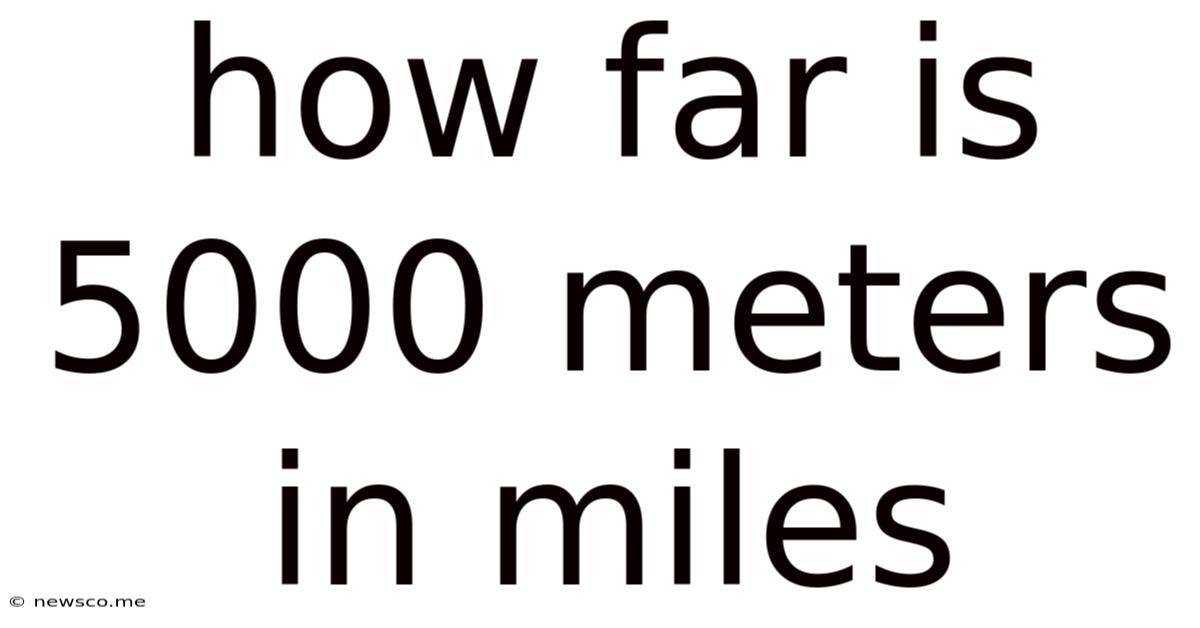How Far Is 5000 Meters In Miles
News Co
Apr 03, 2025 · 4 min read

Table of Contents
How Far is 5000 Meters in Miles? A Comprehensive Guide to Metric-Imperial Conversions
Understanding different unit systems is crucial, especially when dealing with distances. While the metric system (kilometers, meters, centimeters) is predominantly used globally, the imperial system (miles, yards, feet, inches) remains prevalent in several countries, notably the United States. This often leads to the need for quick and accurate conversions, such as determining how far 5000 meters is in miles. This article will delve deep into this specific conversion, exploring the process, providing multiple calculation methods, and offering context to help you better grasp the distance.
Understanding the Metric and Imperial Systems
Before we dive into the conversion, it's helpful to refresh our understanding of the two systems.
The Metric System (SI Units)
The International System of Units (SI), or the metric system, is a decimal system based on powers of 10. This makes conversions relatively straightforward. Key units for distance include:
- Kilometer (km): 1 kilometer = 1000 meters
- Meter (m): The base unit of length.
- Centimeter (cm): 1 meter = 100 centimeters
- Millimeter (mm): 1 meter = 1000 millimeters
The Imperial System
The imperial system is less standardized and involves more complex conversion factors. The most relevant unit for our conversion is:
- Mile (mi): A unit of length commonly used in the United States and some other countries. It's comprised of smaller units like yards and feet.
Converting 5000 Meters to Miles: The Calculation
The fundamental conversion factor we need is the relationship between meters and miles:
1 mile ≈ 1609.34 meters
This means that one mile is approximately equal to 1609.34 meters. The "approximately equal to" symbol (≈) is used because the conversion factor is not an exact whole number.
There are several ways to calculate the conversion:
Method 1: Direct Conversion Using the Conversion Factor
The most straightforward method is to divide the number of meters by the number of meters in a mile:
5000 meters / 1609.34 meters/mile ≈ 3.10686 miles
Therefore, 5000 meters is approximately 3.11 miles.
Method 2: Converting to Kilometers First
We can also convert meters to kilometers first, then kilometers to miles. Since 1 kilometer = 1000 meters:
5000 meters / 1000 meters/kilometer = 5 kilometers
Then, using the conversion factor 1 mile ≈ 1.60934 kilometers:
5 kilometers / 1.60934 kilometers/mile ≈ 3.10686 miles
Again, this yields approximately 3.11 miles.
Method 3: Using Online Conversion Tools
Numerous online conversion tools are available that can perform this calculation instantly. Simply input 5000 meters, select "meters" as the input unit, and "miles" as the output unit. These tools often provide higher precision in their calculations.
Visualizing the Distance: 3.11 Miles
What does 3.11 miles actually represent in real-world terms? Here are some comparisons:
- A moderate run: A brisk 30-minute run for many people would cover a distance of around 3 miles. 5000 meters is slightly longer than this.
- A leisurely walk: A leisurely walk at a moderate pace might take around 45-60 minutes to cover this distance.
- Driving distance: In a car, this distance would be covered in a few minutes, depending on traffic and speed.
The distance is short enough to be manageable on foot but long enough to be considered a substantial walk or run. It's crucial to understand the context in which you're using this distance; a 3.11-mile walk is vastly different from a 3.11-mile drive.
Practical Applications of the Conversion
Knowing how to convert 5000 meters to miles (and vice-versa) has several practical applications:
- Travel planning: Converting distances in maps or travel itineraries between metric and imperial systems.
- Sports and fitness: Understanding the distances of races or training routes.
- Construction and engineering: Accurate measurements are crucial in these fields, requiring efficient conversions between unit systems.
- Geographical analysis: Working with geographical data often requires converting between different unit systems.
- Everyday life: Even mundane tasks like understanding the distance to a nearby landmark can necessitate these conversions.
Beyond the Conversion: Mastering Unit Conversions
The ability to convert between different units of measurement is a valuable skill across various disciplines. Here are some tips for mastering unit conversions:
- Memorize key conversion factors: Familiarize yourself with common conversion factors, such as the meter-mile conversion, and others like kilometers to miles, feet to meters, etc.
- Practice regularly: The more you practice, the more comfortable you will become with these conversions. Try solving different conversion problems to improve your skills.
- Utilize online tools: Online conversion calculators can be a great resource for checking your work and for complex conversions.
- Understand the underlying principles: Instead of simply memorizing formulas, understand the logic behind the conversions. This will make it easier to tackle unfamiliar conversions.
Conclusion
Converting 5000 meters to miles, yielding approximately 3.11 miles, highlights the importance of understanding and effectively applying unit conversion techniques. This seemingly simple conversion has broader implications across various fields and everyday scenarios, demonstrating the need for proficiency in navigating different measurement systems. By mastering this skill, you'll enhance your problem-solving abilities and better comprehend information presented in various units. Remember to choose the calculation method that best suits your needs and always double-check your work, especially in situations requiring precision.
Latest Posts
Related Post
Thank you for visiting our website which covers about How Far Is 5000 Meters In Miles . We hope the information provided has been useful to you. Feel free to contact us if you have any questions or need further assistance. See you next time and don't miss to bookmark.